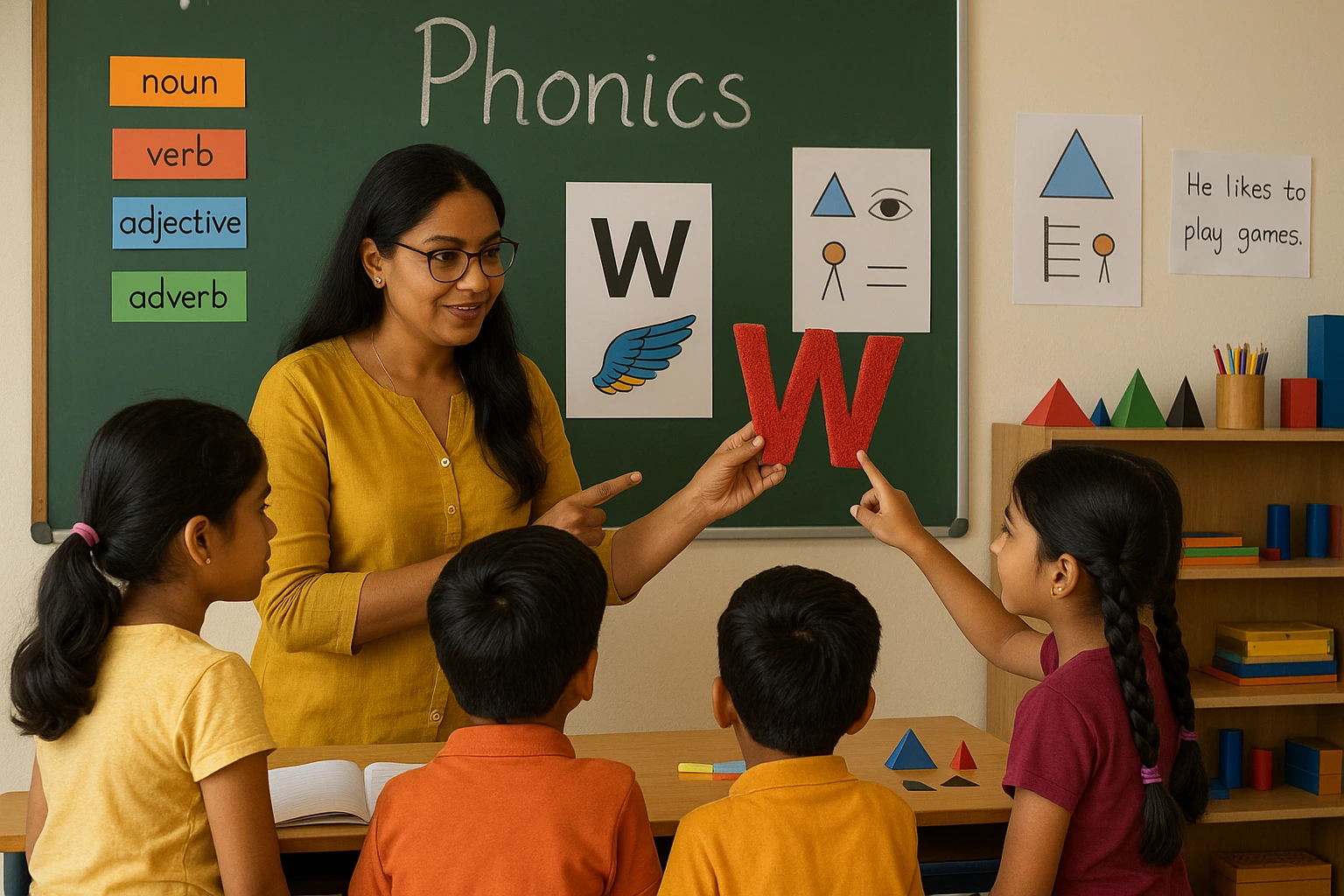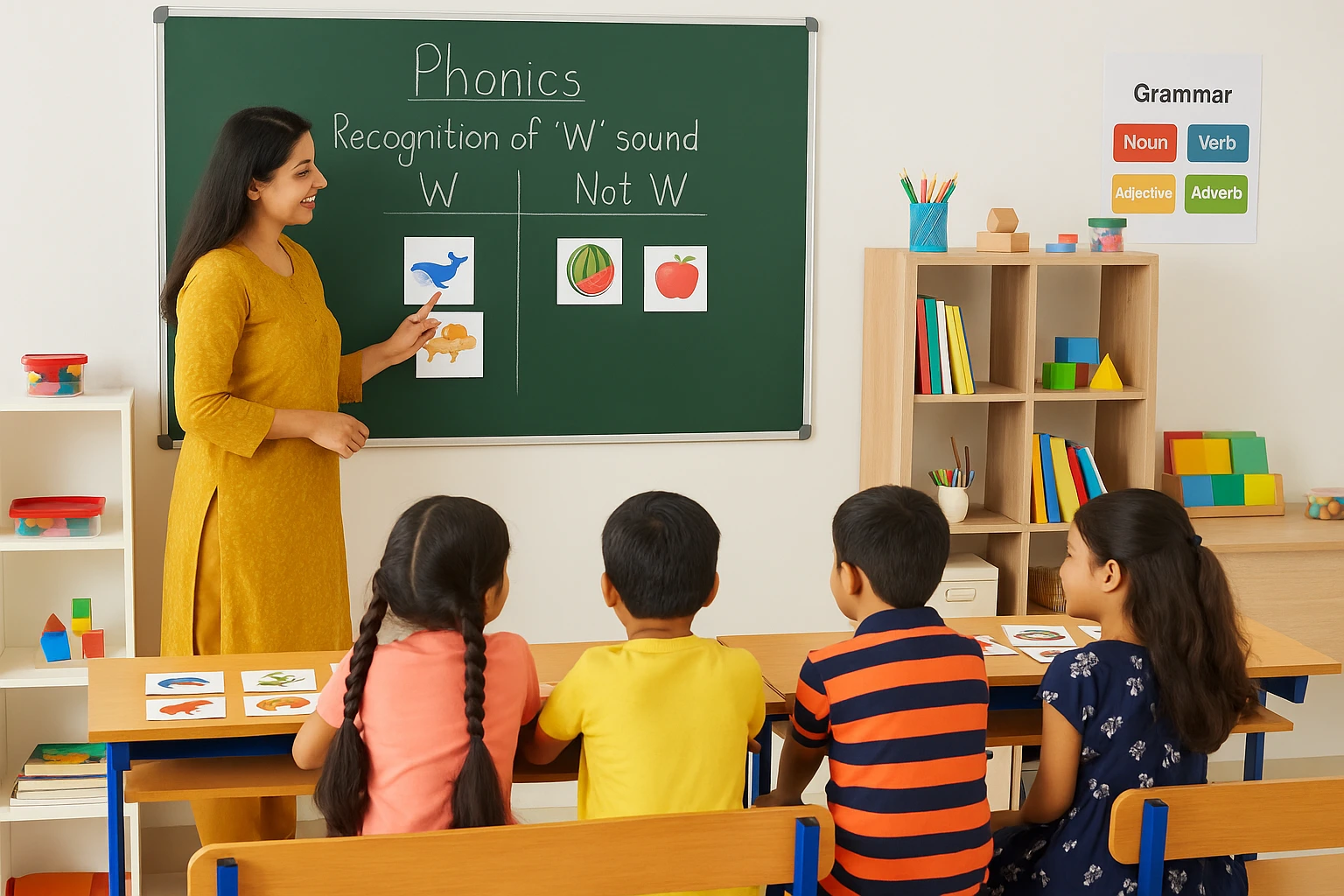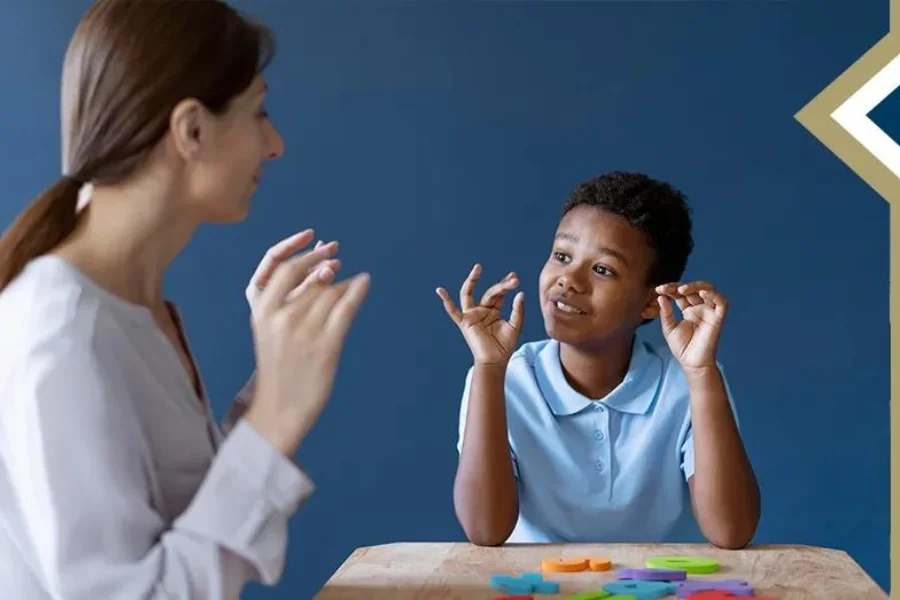Engaging Methods to Teach the Phonics W Sound
Source: dnyansaheb
Engaging Methods to Teach the Phonics W Sound
Introducing the Phonics W Sound can be both effective and enjoyable when done using simple, hands-on methods. The Phonics ‘W’ Sound often puzzles young learners, but with the proven approach, it becomes easy to understand and pronounce. Using visual aids, movement-based games, and repetitive practice helps children grasp the Phonics W Sound naturally.
These fun techniques not only hold their attention but also build lasting connections with the sound. Whether you’re a teacher or a parent, these Engaging Methods to Teach the Phonics ‘W’ Sounds can support your efforts in helping children recognize, say, and use the ‘W’ sound with growing confidence and clarity.
Table of Content
Simple Ways to Teach the ‘W’ Sound that Actually Work
Familiarizing the Phonics Sound of W can be fun and effective when done with suitable strategies. The ‘W’ sound is categorized as a voiced glide, indicating it is produced with vocal cord vibration and a smooth mouth transition. Many children need help differentiating the ‘W’ sound from identical ones like ‘V’ or ‘OO.’ By using practical and consistent techniques, educators and parents can help children master this sound with ease.
Below are Simple Ways to Teach the ‘W’ Sound that Actually Work:
Use Visual and Auditory Cues
- Show how the lips form a small circle when saying the Phonics Sound of W.
- Pair this with a mirror so children can see themselves mimicking the shape.
- Use a slow, clear model of the sound: “Wuh-wuh-water.”
Children often connect faster when they can see and hear the correct articulation. This method helps them understand what the Phonics Sound of W looks and feels like.
Start with Familiar Words
- Begin with high-frequency words: water, window, wagon, and whale.
- Use flashcards or picture books to link the Phonics Sound of W with objects.
- This approach builds a solid vocabulary around the target sound.
It also supports early readers who benefit from repetition and familiarity. Each word becomes a cue that reinforces the correct pronunciation of the Phonics Sound of W.
Play Sound Sorting Games
- Create a mix of images that begin with ‘W’ and others that don’t.
- Ask children to sort them into two groups based on initial sounds.
- Discuss each choice to explain why the Phonics Sound of W does or does not apply.
Games like these promote auditory discrimination, which is critical in phonics learning. It keeps children engaged while they fine-tune their listening skills.
Use Hand Motions or Gestures
- Pair the sound with a gesture, like pretending to blow wind (for “wuh”).
- Use the gesture every time the Phonics Sound of W is practiced.
This adds a kinaesthetic element, helping children remember the sound through body movement. Multisensory methods are especially useful for children who benefit from physical cues.
Practice with Tongue Twisters and Songs
- Try easy tongue twisters: “Wendy wore a woolly white wig.”
- Use songs that emphasize the Phonics Sound of W, such as “What’s the Weather?”
These Engaging Methods to Teach the Phonics ‘W’ Sound make learning enjoyable and memorable. Children naturally repeat songs and rhymes, which boosts their articulation and rhythm with the sound.
Use Repetitive Reading and Echo Practice
- Choose books that emphasize the ‘W’ sound and read them repeatedly.
- Encourage echo reading: The adult reads a word or phrase, and the child repeats.
This method provides a structured way to reinforce the Phonics Sound of W through exposure and immediate practice. It improves both confidence and fluency.
Correct Gently with Positive Feedback
- If a child mispronounces the sound, model the correct pronunciation clearly.
- Praise their effort and guide them to try again.
Consistent, kind correction helps children self-monitor and adjust. They become more aware of how the Phonics Sound of W should be spoken without fear of making mistakes.
Mastering the Phonics W Sound takes time, patience, and continuous exposure. With engrossing methods like visual cues, word plays, jingles, and motions, children can learn to enunciate the ‘W’ sound confidently. Each of these methods supports learning in diverse ways, making them highly practical for various learning styles. By incorporating these Simple Ways to Teach the ‘W’ Sound that Actually Works, educators and caregivers can help children build robust phonics foundations.
To download the brochure of Phonics Course, Click Here!
Call or Whatsapp on +918104606573 / +919869546913, to know more about Phonics Course!

Make Learning the ‘W’ Sound Fun and Easy
Learning the Phonics W Sound can be exciting for young learners when introduced using the suited techniques. Children usually struggle with producing the ‘W’ sound correctly, particularly if they mix it up with identical sounds like /v/ or /oo/.
Well-structured Phonics Classes can streamline this process by familiarizing multisensory methods and entertaining activities that reinforce correct pronunciation. A quality phonics program guarantees that the Phonics Sound of W is introduced in a clear, fun, and consistent manner.
Here’s how Phonics Classes Make Learning the ‘W’ Sound Fun and Easy:
Sound Recognition Games
Through songs, flashcards, and matching activities, children learn to hear and distinguish the Phonics Sound of W from other sounds.
Visual and Tactile Aids
Using picture cards or mouth movement diagrams helps children see how the Phonics Sound of W is made, making it easier to imitate.
Repetitive Practice with Variation
Repeating the sound in different formats—narratives, rhymes, tongue twisters—keeps children interested while boosting their skills.
Phonics-Based Reading Practices
Students read short words like wig, wet, win, etc., which strengthens their familiarity with the Phonics Sound of W in context.
Articulating and Listening Activities
Phonics Classes emphasize auditory discrimination and proper pronunciation, fostering children to hear and practice the sound with guidance.
Trustworthy Phonics Classes don’t simply familiarize letters and sounds—they create a dynamic learning atmosphere where children feel confident and safe trying new things. When a part of an engrossing routine that promotes participation and honors progress, the Phonics Sound of W becomes more effortless to learn.
To download the brochure of Phonics Course, Click Here!
Call or Whatsapp on +918104606573 / +919869546913, to know more about Phonics Course!

Teach the ‘W’ Sound with Confidence
Teaching the Phonics W Sound can be fun and effective when approached with adept strategies. The /w/ sound, as in “water” or “wind,” is a delicate glide sound that many children can grasp with consistent support. Parents and teachers can use targeted approaches to help children identify, produce, and apply the Phonics Sound of W in everyday language.
Here are some detailed tips to Teach the ‘W’ Sound with Confidence:
Use Visual and Tactile Cues
Show children how to round their lips as if blowing out a candle when saying the /w/ sound. Use a mirror so they can observe the lip shape and airflow. Repetition with visual feedback helps them understand how the Phonics Sound of W is formed.
Practice with Familiar Words
Start with simple words like “wet,” “win,” and “wag.” Use flashcards and picture cues to help children connect sounds to images. Repeating these words in songs or stories reinforces the Phonics Sound of W naturally.
Incorporate Movement and Sound Games
Activities like “What’s in the Wagon?” where children pull out items that start with the /w/ sound, keep learning active. Movement-based phonics games increase engagement and strengthen sound recognition.
Model Correct Pronunciation Consistently
Children learn best through repetition. Emphasize the Phonics Sound of W in daily conversation by clearly pronouncing /w/ words. Positive reinforcement and praise will boost their motivation.
Use Sound Sorting Activities
Provide a mix of /w/ and non-/w/ words. Let children sort them into correct categories. This builds listening skills and deepens understanding of the Phonics Sound of W.
Teaching the Phonics W Sound becomes easier when pedagogy is lively, consistent, and supportive. These practical tips offer an integrated yet fun way to build strong phonemic awareness.
To download the brochure of Phonics Course, Click Here!
Call or Whatsapp on +918104606573 / +919869546913, to know more about Phonics Course!

Unlock the ‘W’ Sound with Smart Phonics Methods
Mastering the Phonics W Sound is an important step in early reading development. For many young learners, distinguishing and producing the /w/ sound correctly can be tricky. The Phonics Classes at Vidhyanidhi Education Society (Govt. Regd.) are carefully structured to help children build a strong foundation in phonemic awareness, especially in identifying and using the Phonics W Sound with confidence.
Here’s how these Phonics Classes Unlock the ‘W’ Sound with Smart Phonics Methods:
Focused Sound Recognition
Children are taught to listen to the Phonics W Sound in different word positions—beginning, middle, and end. Repeated exposure to clear examples such as water, window, and wonder helps develop auditory discrimination.
Interactive Learning Tools
Vidhyanidhi’s Phonics Classes use visual aids, flashcards, and digital content that highlight the Phonics W Sound. This multi-sensory approach reinforces sound-letter association, making learning more effective.
Articulation Practice
Correct mouth formation is essential for producing the Phonics W Sound. Pronunciation exercises using mirrors and vocal activities help learners become proficient in articulation.
Phonics Games and Activities
The classes combine phonics games like sound sorting, matching, and sound hunts to keep learners engaged while repeatedly exposing them to the Phonics W Sound in a playful context.
Individual Attention
Every child receives focused guidance in these Phonics Classes, which ensures that those who struggle with specific sounds like /w/ get the support they need without feeling left behind.
Vidhyanidhi Education Society’s (Govt. Regd.) structured phonics methods are trusted by parents and educators alike for their ability to turn tricky sounds into strengths. If your child is struggling with the Phonics W Sound, these expert-led sessions provide the tools and confidence needed to progress smoothly in reading and speaking.
Make learning fun—join Vidhyanidhi’s Phonics Course and teach ‘W’ with ease!
To download the brochure of Phonics Course, Click Here!
Call or Whatsapp on +918104606573 / +919869546913, to know more about Phonics Course!
FAQs
How often should I Practice the 'W' Sound with a Child?
Practice the 'W' sound daily for 5–10 minutes using fun, engaging games or story time.
Should I Introduce the 'W' Sound with Uppercase or Lowercase Letters First?
Start with lowercase 'w' as it's more common in reading; introduce uppercase once recognition is strong.





